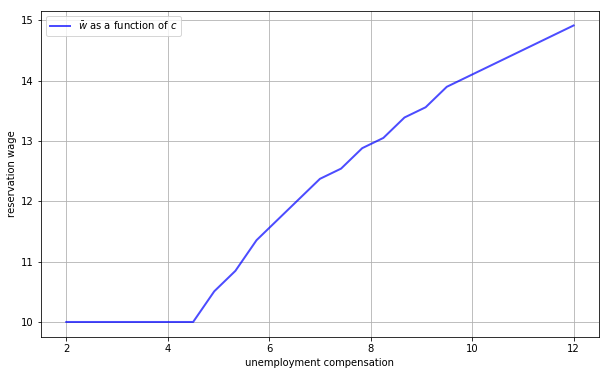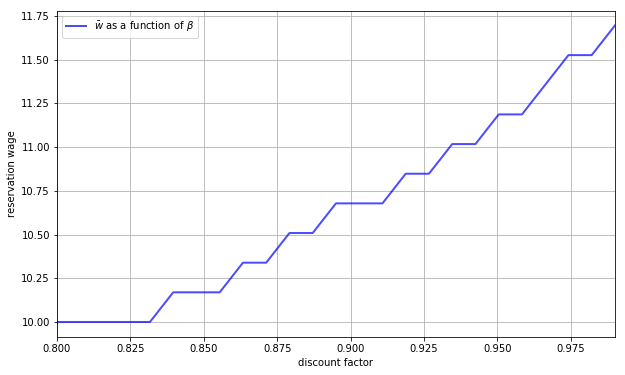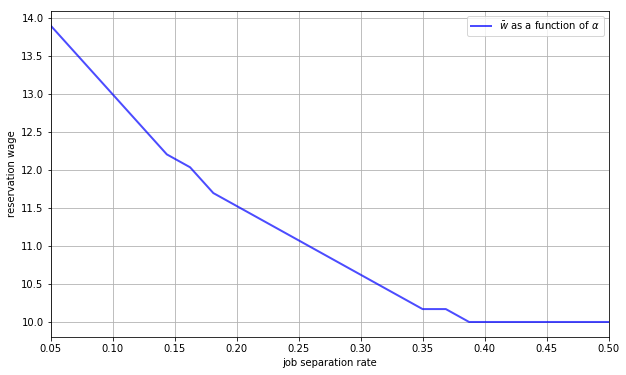29. Job Search II: Search and Separation#
Contents
29.1. Overview#
Previously we looked at the McCall job search model [McC70] as a way of understanding unemployment and worker decisions.
One unrealistic feature of the model is that every job is permanent.
In this lecture we extend the McCall model by introducing job separation.
Once separation enters the picture, the agent comes to view
the loss of a job as a capital loss, and
a spell of unemployment as an investment in searching for an acceptable job
using LinearAlgebra, Statistics
using Distributions, LaTeXStrings, NLsolve, Plots
29.2. The Model#
The model concerns the life of an infinitely lived worker and
the opportunities he or she (let’s say he to save one character) has to work at different wages
exogenous events that destroy his current job
his decision making process while unemployed
The worker can be in one of two states: employed or unemployed.
He wants to maximize
The only difference from the baseline model is that
we’ve added some flexibility over preferences by introducing a utility function
It satisfies
29.2.1. Timing and Decisions#
Here’s what happens at the start of a given period in our model with search and separation.
If currently employed, the worker consumes his wage
If currently unemployed, he
receives and consumes unemployment compensation
receives an offer to start work next period at a wage
He can either accept or reject the offer.
If he accepts the offer, he enters next period employed with wage
If he rejects the offer, he enters next period unemployed.
When employed, the agent faces a constant probability
(Note: we do not allow for job search while employed—this topic is taken up in a later lecture)
29.3. Solving the Model using Dynamic Programming#
Let
Here value means the value of the objective function (29.1) when the worker makes optimal decisions at all future points in time.
Suppose for now that the worker can calculate the function
Then
and
Let’s interpret these two equations in light of the fact that today’s tomorrow is tomorrow’s today.
The left hand sides of equations (29.2) and (29.3) are the values of a worker in a particular situation today.
The right hand sides of the equations are the discounted (by
But tomorrow the worker can be in only one of the situations whose values today are on the left sides of our two equations.
Equation (29.3) incorporates the fact that a currently unemployed worker will maximize his own welfare.
In particular, if his next period wage offer is
Equations (29.2) and (29.3) are the Bellman equations for this model.
Equations (29.2) and (29.3) provide enough information to solve out for both
Before discussing this, however, let’s make a small extension to the model.
29.3.1. Stochastic Offers#
Let’s suppose now that unemployed workers don’t always receive job offers.
Instead, let’s suppose that unemployed workers only receive an offer with probability
If our worker does receive an offer, the wage offer is drawn from
He either accepts or rejects the offer.
Otherwise the model is the same.
With some thought, you will be able to convince yourself that
and
29.3.2. Solving the Bellman Equations#
We’ll use the same iterative approach to solving the Bellman equations that we adopted in the first job search lecture.
Here this amounts to
make guesses for
plug these guesses into the right hand sides of (29.4) and (29.5)
update the left hand sides from this rule and then repeat
In other words, we are iterating using the rules
and
starting from some initial conditions
Formally, we can define a “Bellman operator” T which maps:
In which case we are searching for a fixed point
As before, the system always converges to the true solutions—in this case,
the
A proof can be obtained via the Banach contraction mapping theorem.
29.4. Implementation#
Let’s implement this iterative process
using Distributions, LinearAlgebra, NLsolve, Plots
function solve_mccall_model(mcm; U_iv = 1.0, V_iv = ones(length(mcm.w)),
tol = 1e-5,
iter = 2_000)
(; alpha, beta, sigma, c, gamma, w, dist, u, p) = mcm
# parameter validation
@assert c > 0.0
@assert minimum(w) > 0.0 # perhaps not strictly necessary, but useful here
# necessary objects
u_w = mcm.u.(w, sigma)
u_c = mcm.u(c, sigma)
# Bellman operator T. Fixed point is x* s.t. T(x*) = x*
function T(x)
V = x[1:(end - 1)]
U = x[end]
[u_w + beta * ((1 - alpha) * V .+ alpha * U);
u_c + beta * (1 - gamma) * U + beta * gamma * dot(max.(U, V), p)]
end
# value function iteration
x_iv = [V_iv; U_iv] # initial x val
xstar = fixedpoint(T, x_iv, iterations = iter, xtol = tol, m = 0).zero
V = xstar[1:(end - 1)]
U = xstar[end]
# compute the reservation wage
wbarindex = searchsortedfirst(V .- U, 0.0)
if wbarindex >= length(w) # if this is true, you never want to accept
w_bar = Inf
else
w_bar = w[wbarindex] # otherwise, return the number
end
# return a NamedTuple, so we can select values by name
return (; V, U, w_bar)
end
solve_mccall_model (generic function with 1 method)
The approach is to iterate until successive iterates are closer together than some small tolerance level.
We then return the current iterate as an approximate solution.
Let’s plot the approximate solutions
We’ll use the default parameterizations found in the code above.
function mcall_model(; alpha = 0.2,
beta = 0.98, # discount rate
gamma = 0.7,
c = 6.0, # unemployment compensation
sigma = 2.0,
u = (c, sigma) -> (c^(1 - sigma) - 1) / (1 - sigma),
w = range(10, 20, length = 60), # wage values
dist = BetaBinomial(59, 600, 400)) # distribution over wage values
p = pdf.(dist, support(dist))
return (; alpha, beta, gamma, c, sigma, u, w, dist, p)
end
mcall_model (generic function with 1 method)
# plots setting
mcm = mcall_model()
(; V, U) = solve_mccall_model(mcm)
U_vec = fill(U, length(mcm.w))
plot(mcm.w, [V U_vec], lw = 2, alpha = 0.7, label = [L"V" L"U"])
The value
At this point, it’s natural to ask how the model would respond if we perturbed the parameters.
These calculations, called comparative statics, are performed in the next section.
29.5. The Reservation Wage#
Once
If
If
Suppose in particular that
Then, since
We denote this wage
Optimal behavior for the worker is characterized by
if the wage offer
if the wage offer
If
Let’s use it to look at how the reservation wage varies with parameters.
In each instance below we’ll show you a figure and then ask you to reproduce it in the exercises.
29.5.1. The Reservation Wage and Unemployment Compensation#
First, let’s look at how
In the figure below, we use the default parameters in the mcall_model tuple, apart from c (which takes the values given on the horizontal axis)

As expected, higher unemployment compensation causes the worker to hold out for higher wages.
In effect, the cost of continuing job search is reduced.
29.5.2. The Reservation Wage and Discounting#
Next let’s investigate how
The next figure plots the reservation wage associated with different values of

Again, the results are intuitive: More patient workers will hold out for higher wages.
29.5.3. The Reservation Wage and Job Destruction#
Finally, let’s look at how
Higher

Once more, the results are in line with our intuition.
If the separation rate is high, then the benefit of holding out for a higher wage falls.
Hence the reservation wage is lower.
29.6. Exercises#
29.6.1. Exercise 1#
Reproduce all the reservation wage figures shown above.
29.6.2. Exercise 2#
Plot the reservation wage against the job offer rate
Use
gamma_vals = range(0.05, 0.95, length = 25)
0.05:0.0375:0.95
Interpret your results.
29.7. Solutions#
29.7.1. Exercise 1#
Using the solve_mccall_model function mentioned earlier in the lecture,
we can create an array for reservation wages for different values of
c_vals = range(2, 12, length = 25)
models = [mcall_model(c = cval) for cval in c_vals]
sols = solve_mccall_model.(models)
w_bar_vals = [sol.w_bar for sol in sols]
plot(c_vals,
w_bar_vals,
lw = 2,
alpha = 0.7,
xlabel = "unemployment compensation",
ylabel = "reservation wage",
label = L"$\overline{w}$ as a function of $c$")
Note that we could’ve done the above in one pass (which would be important if, for example, the parameter space was quite large).
w_bar_vals = [solve_mccall_model(mcall_model(c = cval)).w_bar
for cval in c_vals];
# doesn't allocate new arrays for models and solutions
29.7.2. Exercise 2#
Similar to above, we can plot
gamma_vals = range(0.05, 0.95, length = 25)
models = [mcall_model(gamma = gammaval) for gammaval in gamma_vals]
sols = solve_mccall_model.(models)
w_bar_vals = [sol.w_bar for sol in sols]
plot(gamma_vals, w_bar_vals, lw = 2, alpha = 0.7, xlabel = "job offer rate",
ylabel = "reservation wage",
label = L"$\overline{w}$ as a function of $\gamma$")
As expected, the reservation wage increases in
This is because higher
Hence workers are less willing to accept lower offers.
